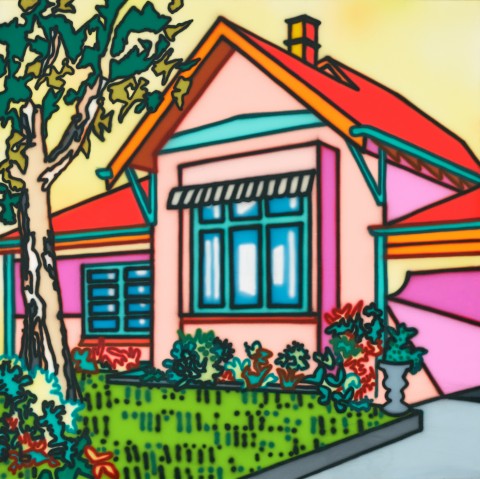EASTERN SUBURBS PINK HOME, 1991
HOWARD ARKLEY
synthetic polymer paint on canvas
163.0 x 163.0 cm
signed, dated and inscribed verso: Name Howard Arkley / Title Eastern Suburbs Pink Home / Date 1991 / Size 630 mm x 630 [sic.] mm / Medium Acryic [sic.] on Canvas
Tolarno Galleries, Melbourne
Private collection, Sydney, purchased from the above 10 July 1991
Howard Arkley Online Catalogue Raisonné: [http://arkleyworks.com/blog/2020/09/14/eastern-suburbs-pink-home-1991/] (accessed 14/09/20)
Around the turn of the twentieth century, by and large, Australian art had only minimal recognition beyond these shores. One may have encountered the odd individual who could recognise a Sidney Nolan Ned Kelly, or a Whiteley Lavender Bay, or even the powerful swirls and slashes of an Emily Kame Kngwarreye canvas. But these were rare occurrences indeed.
There was an exception to this dearth of knowledge however, and that exception was the late Howard Arkley. When the Melbourne-based artist was launched internationally with his ‘Howard Arkley: The Home Show’ at the Australian Pavilion for the 48th Venice Biennale in 1999 it was an instant hit, a blazing contrast to the largely dour European, American and Asian offerings on show. When I was introduced to the famous Pop artist Roy Lichtenstein, it seemed that all he wanted to talk about was ‘this Australian artist’ who was, to Lichtenstein, the clear stand-out of the event.
There was a clear reason for this. For one thing, Arkley’s imagery was immediately recognisable and relatable. All industrialised nations have their share of suburbia or versions thereof. These are, of course, largely eschewed locales devoid of ‘culture,’ the realm of the riff raff and the domain of the mundane. But Arkley, single-handedly, turned this assumption on its head. ‘The Home Show’ was clearly a celebration, a clarion call to the minutiae of our built environments and everyday existence.
Although he dabbled in abstraction and tackled other subject matter, from freeways to shadow factories, it is the suburban home that remains the artist’s singular legacy. Eastern Suburbs Pink Home, 1991, captures the appeal of Arkley’s oeuvre succinctly. It is a trophy from one of Arkley’s suburban safaris, an icon of the kind most of us drive past with nary a nod to its existence. Of course the artist has applied his wonderfully garish, almost hallucinogenic palette, in his homage to the home. He came of age during the Age of Punk and thus breaking rules ran deep. In Eastern Suburbs Pink Home colours that shouldn’t co-exist shudder the canvas into weird harmonies. The body of this single-fronted brick veneer is a mild pink, a sun-bleached frontage which retains it brighter, more garish, origins on the side of the home. But the gable is a vivid orange. One wants to respond that no-one in their right mind would paint a house with that berserk combination of colours. No-one, that is, except Howard Arkley.
In an age when intellectual discourse infiltrates the visual arts on all levels, Arkley’s works are instantly recognisable—they are images that portray a part of the Australian psyche. They are the house down the road, the street we grew up in, the suburb where grandma lives. One of Arkley’s favourite stories was of standing behind two middle-aged women looking at one of his paintings in the National Gallery of Victoria and hearing one of them say, ‘Look, that’s just like Dot’s house!’
For Arkley that was the ultimate compliment. For Arkley his subject was a celebration. And perhaps indeed, Dot once resided in that very Eastern Suburbs Pink Home.
DR. ASHLEY CRAWFORD
